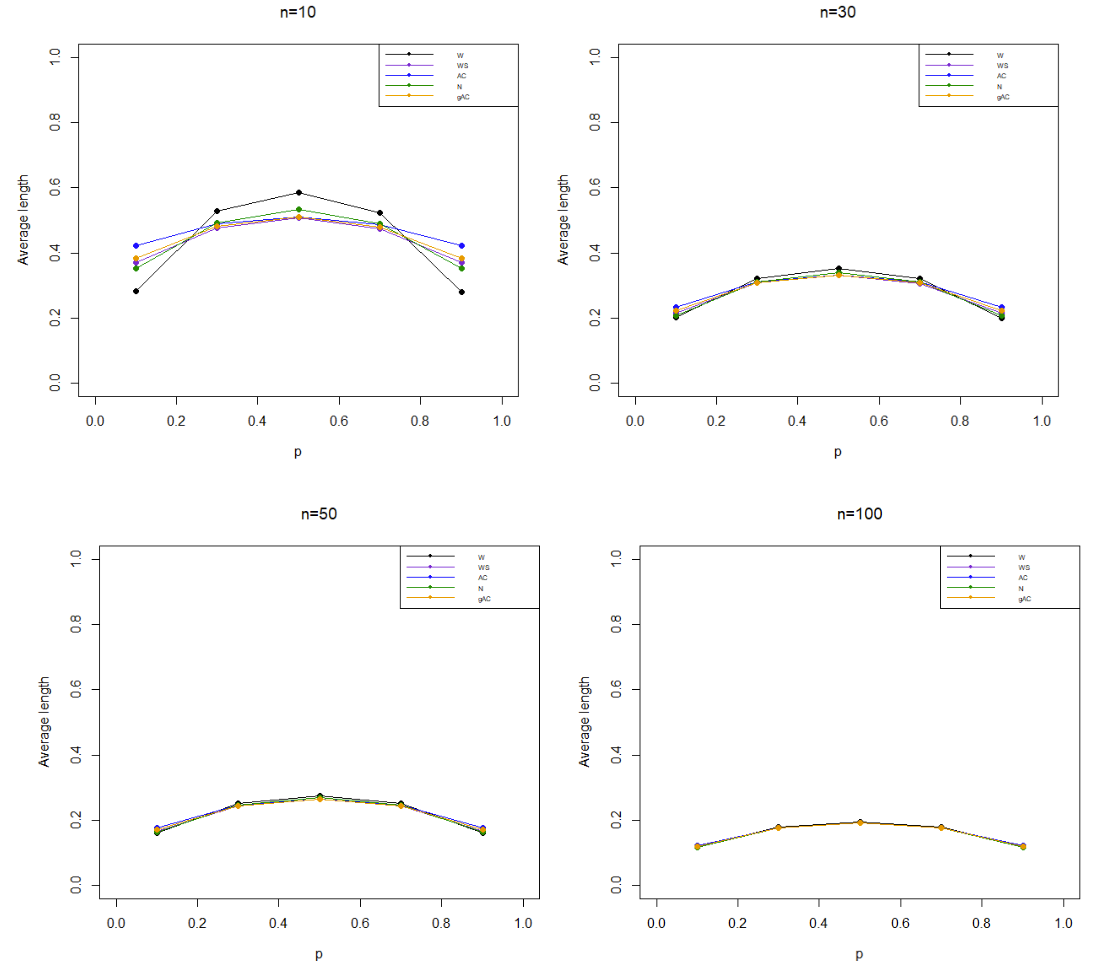Comparison of Methods on Asymptotic and Exact Confidence Intervals for a Binomial Proportion with Application
Keywords:
Confidence interval, Binomial proportion parameter, Coverage probability, Monte Carlo simulationAbstract
The objective of this research was to compare efficiency of the methods for estimating two types of confidence interval for a binomial proportion, which are exact confidence interval and asymptotic confidence interval by studying comparison upon 5 methods for estimating confidence interval. These 5 methods are Wald method, Wilson Score method, Agresti-Coull method, New method, and generalized Agresti-Coull method. The data was simulated by using Monte Carlo method, utilizing binomial distribution with parameters and that determine sizes of the sample equal to 10, 30, 50, and 100. Meanwhile, the values of proportion were determined as 0.1, 0.3, 0.5, 0.7, and 0.9 with confidence level 95% by repeating experiment 10,000 times in each certain circumstance. Moreover, the criteria used to compare efficiency of confidence intervals was coverage probability as well as average length. According to research findings, it can be summarized as follows. Confidence interval of Wilson Score method showed the best efficiency in diverse circumstances in case study. Besides, this confidence interval was appropriate for the circumstance at when and when was close to 0 or 1, and for every value of except Furthermore, confidence interval of Agresti-Coull method had the most second efficiency, which was appropriate for when and and when whereas confidence interval of New method had the third most efficiency, which was appropriate for and when value of was close to 0 or 1. At the same time, confidence interval of generalized Agresti-Coull method had the fourth most efficiency, which was appropriate for when and However, confidence interval of Wald method possess quite low precision. In addition, confidence interval of these 5 methods can be applicable to the real data in any circumstances.
References
Agresti, A.,& Coull, B. A. (1998). Approximate is better than “Exact” for interval estimation of binomial proportions. The American Statistician, 52(2),118-126. https://doi.org/10.1080/00031305.1998.10480550
Brown, L. D., Cai, T.,& Dasgupta, A. (2001). Interval estimation for a binomial proportion. Statistical Science,16(2), 101-133. https://doi.org/10.1214/ss/1009213286
Brown, L. D., Cai, T.,& Dasgupta, A. (2002). Confidence intervals for a binomial proportion and asymptotic expansions. The Annals of Statistics,30(1), 160-201. https://doi.org/10.1214/aos/1015362189
Cao, Y., Xu, Y., Tan, M. T., Chen, P., & Duan, C. (2022). A simple and improved score confidence interval for a single proportion.Communications in Statistics-Theory and Methods,51(8), 2659-2675. https://doi.org/10.1080/03610926.2020.1779747
Clopper, C. J.,& Pearson, E. S. (1934). The use of confidence or fiducial limits illustrated in the case of the binomial. Biometrika, 26(4), 404-413.
Fisher, A. R.,& Cornish, E. A. (1960). The percentile points of distributions having known cumulants. American Society for Quality, 2(2),209-225.
Kim, J.,& Jang, W. (2022). A generalized Agresti-Coull type confidence interval for a binomial proportion. Journal of the Korean Statistical Society, 51, 356-377. https://doi.org/10.1007/s42952-021-00143-3
Komoltri, J. (2012). Sample size calculation. Journal of Mental Health of Thailand, 20(3), 192-198. (in Thai)
Mizumoto, K., Kagaya, K., Zarebski, A.,& Chowell, G. (2020). Estimating the Asymptomatic Proportion of Coronavirus Disease 2019 (COVID-19) Case on Board the Diamond Princess Cruise Ship, Yokohama, Japan, 2020. Euro Surveill, 25(10), 1-5. https://doi.org/10.2807/1560-7917. ES.2020.25.10.2000180
Muenmee, S.,& Bootdee, S. (2021). Health risk assessment of exposure PM2.5 from industrial area in Pluak Daeng District, Rayong province. Naresuan Phayao Journal, 14(3), 95-110. (in Thai)
Wald, A. (1943). Tests of statistical hypotheses concerning severalparameters when the number of observations is Large. American Mathematical Society, 54(3), 426-482.
Wilson, E. B. (1927). Probable inference, the law of succession, and statistical inference. Journal of the American Statistical Association, 22(158), 201-212. https://doi.org/10.2307/2276774

Downloads
Published
License
Copyright (c) 2023 Journal of Applied Science and Emerging Technology

This work is licensed under a Creative Commons Attribution-NonCommercial-NoDerivatives 4.0 International License.

